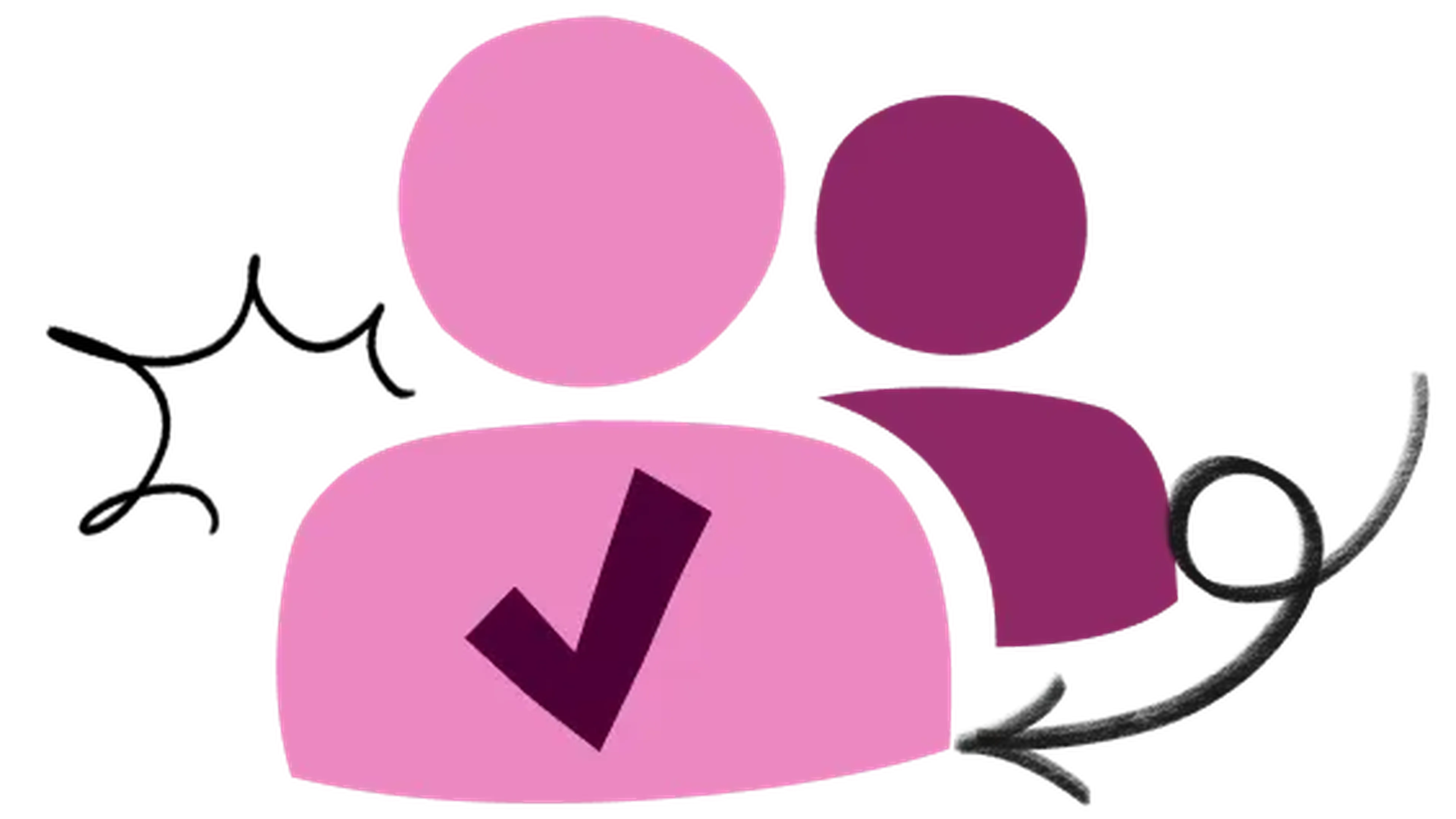02 Jun 2025
|14 min
Semi-structured interviews
Explore the versatility of semi-structured interviews. Learn how to conduct, analyze, and leverage insights for impactful user research.

Semi-structured interviews are the bread and butter of qualitative research. Why?
One of their main advantages is that they’re "the best of both worlds" – you get some of the organization of structured interviews while also allowing the flexibility to ask open-ended questions based on the participant’s responses.
In user research, the flexibility of semi-structured interviews means this method has many use cases, from generating exploratory insights to helping validate design ideas.
This guide will help you gain a deeper understanding of semi-structured interviews as a user research method and how to conduct them. We'll be covering:
What is a semi-structured interview for user research?
Advantages and disadvantages of semi-structured interviews
Semi-structured interview question examples
How to conduct a semi-structured interview
Analyzing results from a semi-structured interview study
Presenting semi-structured interview findings
By the end of this article, you should feel confident (and itching!) to start building a semi-structured interview research study.
What is a semi-structured interview for user research?
A semi-structured interview is a data collection method that uses a general set of questions about your research topic as a guide to help direct a user interview, but isn't limited by those questions.
Unlike structured interviews, where you phrase and place questions in the same order for every interview, semi-structured interviews typically use open-ended questions that don't necessarily have to be in the same order. However, since there’s still a list of predetermined questions to guide you, it's not as flexible and exploratory as unstructured interviews.
Streamline your user interviews with Lyssna
Ready to conduct insightful semi-structured interviews? Lyssna helps you recruit participants, schedule sessions, and automatically transcribe interviews.
When should you use semi-structured interviews?
While structured interviews are pretty easy for most people to handle, semi-structured interviews require a little more interviewing experience. That's because it can be more challenging to improvise appropriate questions on the fly that aren't leading or that don’t introduce bias.
Another aspect to consider is that semi-structured interviews are more exploratory, given the wide range of potential responses from open-ended questions.
As a result, you should think about conducting semi-structured interviews after initial concept designs but still before building a minimum viable product (MVP).
Semi-structured interviews are also a great tool in a continuous product discovery cycle weather you're focusing on generative vs evaluative research or exploring the differences between quantitative vs qualitative research, to help gain new perspectives on an existing product.
Advantages and disadvantages of semi-structured interviews
Before we discuss some of the practical details of conducting semi-structured interviews, let's consider their pros and cons. While this method is widely used, it might not be the best choice depending on your research question and objective.
Advantages of semi-structured interviews
"The best of both worlds": Regarding the differences between structured, semi-structured, and unstructured interviews, semi-structured interviews sit in the middle. They combine elements of the other two approaches, providing an outline with the freedom to color outside the lines a little.
Allows for guided yet free-flowing conversation: For interviewers with some experience, a semi-structured interview provides the flexibility to ask clarifying questions and probe deeper into responses but still has a safety net of questions to go back to if the conversation strays too far.
Get more detailed, rich responses: A semi-structured interview is much more likely to garner detailed responses than a structured one. This is because open-ended questions are less structured. Also, you can build a better connection with participants and ask follow-up questions based on the answers.
Disadvantages of semi-structured interviews
It can reduce validity: If you stray from the original set of planned questions, your study may be less valid. This is because the conversation will move away from the research questions. It will also be hard to compare data between participants.
Increases the risk of bias: Since at least some of the questions will be partially improvised, you can unintentionally introduce bias into the new questions or ask leading questions, invalidating the responses.
They can be more difficult to plan: Since you can expect some level of improvisation based on unique participant responses, you'll have to keep in mind that you're unlikely to be able to pre-code responses (as you might with a structured interview), which can also make analysis slightly more time-consuming.
Semi-structured interview question examples
Since you're not necessarily looking for demographic or quantifiable data in a semi-structured interview, you'll likely be using open-ended questions, which can be deceptively tricky to get right.
You'll need to word your user interview questions in a way that don’t bias your participants' responses. Some quick tips include making your questions concise, without industry jargon, and thinking about the themes involved in your research question to keep them all on topic.
For example, let’s say your UX research question is, "How do we reduce our website bounce rates?", relating to an objective of improving the website visitor experience. Some example open-ended questions to use in the interview could be:
What prompted you to visit our website for the first time?
Have you ever felt frustrated while browsing a website? If so, can you identify what made you feel that way?
Can you tell me about a time when you decided to leave a website and go to a different one when looking for X information?
These are just a few examples for this scenario, but other open-ended questions you can use include:
What is your first impression of this website? (showing a design concept)
What do you think X product/service does?
Do you think X product/service is similar to another? If so, please explain.
Would X product/service help you complete tasks in your everyday life?
What motivated you to purchase X type of product? Or: What stopped you from making X purchase?
Our top tip for semi-structured interview questions is to start easy – give your participants a chance to warm up before moving on to more complex questions.
How to conduct a semi-structured interview
As with most interview-based research methods, there are three phases to contend with: the pre-interview phase, the interview phase, and the post-interview phase. Each phase is essential for running a successful study.
Pre-interview phase
Unfortunately, one can't simply rock up and interview random participants on the spot. There's a bit of planning involved.
Before the interviews start, you'll need to set everything up appropriately – documenting your research question and objectives, writing up your interview questions, and gathering the right participants.
Ideally, you can recruit participants from your network of existing users. But if that's not possible, you can always use a research panel to find people who match your ideal customer profile (ICP). You'll also need to create a research consent form for participants to acknowledge and sign.
You'll also need to think about where and how you'll conduct your interviews. Many people are more comfortable with remote video calls (thanks to a particular pandemic), which are also helpful if you plan to conduct a lot of interviews. Otherwise, you'll need to organize a mutually beneficial time and place for your participants.
Use our handy discussion guide template to plan your research and document your questions for user interviews.
Interview phase
Once you’ve prepared your research discussion guide and have recruited your participants and organized your interviews, you can start interviewing.
During each interview, you'll want to follow these steps:
Confirm that your participants consent to taking part in your research and agree to be recorded. You should already have written consent, but it's best practice to confirm this at the start of the interview.
It's also best practice to set expectations for the interview, letting participants know about the format and confirming how long the interview will be, giving them a chance to exit the research if they want/need to.
Start the interview with a planned (easy) question to warm up the participant and build rapport.
As the questions proceed, remember to ask clarifying questions and probe deeper into participant responses. However, try to stay on topic and return to your planned questions if the conversation is drifting away.
End the interview – while it's not a "best practice" per se, it's nice for the participant to end with a final easy question and allow them to ask any of their own.
Read our article on how to navigate off-topic conversations during user interviews.
Post-interview phase
Once you've completed all the interviews, you'll need to focus on analyzing and synthesizing your data. However, before you do that, remember to check for any follow-up questions you might have received from your participants and answer those first.
If there aren't any, you can move straight on to your interview transcripts. If you conduct remote interviews, software like Lyssna can automatically transcribe them with great accuracy – otherwise, build time into your post-interview phase for transcription.
With your transcripts in hand, you can start analyzing the data and gathering insights ready to build a research report for your key stakeholders. To help with this process, it's important to understand various ux research synthesis methods that can guide how you make sense of qualitative data and turn it into actionable insights.
Analyzing semi-structured interviews
Unlike structured interviews, you won't have much (if any) statistical data to analyze – instead, you'll have to turn to qualitative methods of analysis, such as those outlined in the 8 types of qualitative research.
The most common method of analysis is thematic analysis, which involves coding the data and using those codes to determine its themes. In other scenarios, a content analysis might be appropriate (for example, if you're using data you've pulled from feedback surveys or reviews).
But first, you'll need to decide if you're taking an inductive or a deductive approach. An inductive approach means you'll let the data guide and determine your themes, whereas a deductive approach helps you investigate whether the data confirms predetermined themes.
If you're taking a deductive approach, you'll need to be mindful of bias as you code your data so as to not fall into a confirmation bias trap.
Qualitative data coding
To analyze your transcripts using thematic analysis, you'll need to examine the text closely to find common topics, patterns, and perhaps even phrasing.
From my experience in qualitative coding during my Master's and PhD research, you'll want to do at least two coding rounds (preferably three), as some codes you add in later data might be relevant to earlier content.
From there, you'll gather your data and group it by code to give you a broad overview of the data in each code. Then, you'll be able to organize the codes into themes (grouping codes together based on their similarity, e.g. shared sentiment or experiences).
Before you call it a day on your themes, you should return to the initial data and double-check that the theme still applies.
Here's an example of what this coding can look like, taken from A Narrative Approach to Qualitative Inquiry by Michelle Butina in the Clinical Laboratory Science journal.
It's worth noting that this method of analysis is quite subjective and can reduce the study's validity. However, you can help combat this validity reduction by having another researcher check your codes and see if they'd use different names or new codes.
Presenting semi-structured interview findings
After analyzing your data and gathering your findings, it's time to package it up for presentation. In most cases, you'll build a ux research report (in other cases, you'll likely use a presentation format).
Regardless of the format you decide to present your research, it will nearly always follow this pattern:
Present the research question and objectives. This helps stakeholders know what the research was trying to achieve.
Methodology. Explain how you approached the research question to help stakeholders understand how you got to your findings.
Results/Findings. Show your findings and describe the themes that emerged from the research. If you were taking a deductive approach, show how the data confirmed (or didn't confirm) your predetermined themes.z
Discussion/Recommendations. Do your findings help answer the research question and achieve its objectives? If not, why? Based on the findings, what are your recommendations moving forward?
You'll likely get questions from your stakeholders about the research, but don't worry – by this point, you've been immersed in it, and you'll know it like the back of your hand.
Easily gather user feedback with Lyssna
Turn your semi-structured interviews into actionable feedback. Use Lyssna to easily manage participants, conduct interviews, and analyze your results.
Get started with user interview research today
Conducting semi-structured user interviews is an excellent method of gaining deep insights into your users' attitudes, behaviors, and preferences. However, even well-designed studies can fall flat if you lack the right tools.
With Interviews from Lyssna, you can quickly recruit the right research participants from a panel of over 690,000 quality participants, screen them, sync multiple calendars, and transcribe your interview sessions.
Using the tips we've discussed in this guide alongside Lyssna can help you streamline your UX research process and get the data you want ready for your next phase of product development.
--
Alexander Boswell is the Founder/Director of SaaSOCIATE, a B2B SaaS, MarTech and eCommerce Content Marketing Service and a Business PhD candidate. When he’s not writing, he’s playing baseball and D&D.
You may also like these articles


Try for free today
Join over 320,000+ marketers, designers, researchers, and product leaders who use Lyssna to make data-driven decisions.
No credit card required






